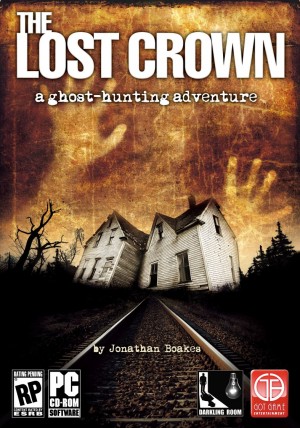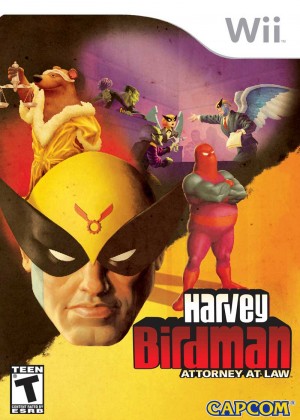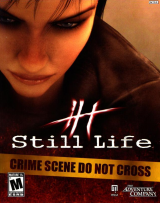Review for Catherine

Vincent Brooks leads a carefree life. A shaggy-haired programmer who lives alone, enjoys a stable relationship with his long-time girlfriend Katherine, and hangs out most nights with his buddies at the Stray Sheep bar, he’s comfortably coasting along. At 32, he’s never had to make a tough, life-changing decision. Then Katherine sits him down for “the talk.” All her friends are getting married and having babies, she tells him. It’s about time they settled down. Get married? The thought of it makes Vincent’s heart pound; he breaks out in a cold sweat. Make a commitment? He heads to the bar to drown his sorrows. He’s still there, drinking alone, when a cute blonde (coincidentally named Catherine) asks if she can sit with him. They talk, they drink, one thing leads to another… and Vincent’s life suddenly becomes a lot more complicated.
This is the story of Catherine, billed an “unconventional romance-horror” by Japanese developer Atlus. In spite of its cartoon artwork and being named after the game’s scantily-dressed namesake, it is not pornographic and it isn't manga. It has some risqué moments, but as far as sex goes, the story’s events are tamer than a lot of R-rated movies. Instead, this is a surprisingly realistic exploration of relationships, morality, and human emotions that has one of the most relatable and intriguing storylines of any recent game, adventure or otherwise.
Okay, but what kind of game is it? Catherine has been called a puzzle game, but that doesn’t mean what most adventure fans expect it to mean. The gameplay alternates between relaxed story scenes where the sole objective is to interact with other characters and tease out the overarching plot, and fast-paced puzzle stages during which Vincent must frantically climb a massive tower of blocks before the bottom falls out beneath him. The game spans eight days, during which cinematics show snippets of Vincent’s daily experiences and interactive story scenes take place each evening at the Stray Sheep. Meanwhile the nine puzzle stages, set during his recurring nightmare, grow more complex as he becomes more deeply entangled in his betrayal—keeping secrets from Katherine, guiltily continuing to see (and sleep with) Catherine, and desperately trying to figure out who he truly is and what he wants out of life.
Vincent’s moral dilemma is at the heart of Catherine’s storyline, but it turns out he’s just one of many men experiencing terrifying nightmares night after night. As he agonizes over the mess he’s in, he starts hearing rumors from his friends and fellow bar patrons about how men who cheat on their girlfriends or wives are being cursed by the one they betrayed. And according to news reports, a string of local men have mysteriously died in their sleep…
During the interactive story scenes, which are exclusively set at the Stray Sheep, Vincent is able to walk around the bar, talk to various characters, and engage in typical activities like choosing music on the jukebox, playing an arcade game, and drinking. There are no puzzles or overriding objectives during these scenes; you can do as much or as little as you want before returning home for the night. However, by talking to other characters, you’ll pick up details about the apparent curse that plagues cheating men and the so-called “weakening deaths” that seem to be linked to Vincent’s own recurring nightmares. Others arrive at and leave the bar on their own timetable, so your decisions about who to speak to and when will influence how much of the backstory you learn. These interactions can also have subtle impacts on how the story unfolds—nothing as drastic as in, say, Heavy Rain, but the fates of NPCs can change and minor scenes will differ depending on how you spend your free time.
While at the bar, Vincent receives text messages and the occasional phone call from the two women in his life. How you choose to respond (if you respond at all) also influences the story in subtle ways. When Catherine sends a suggestive photo of herself, you can egg her on or tell her to stop. When Katherine texts that she’s frustrated about Vincent’s reluctance to commit, you can reassure her or blow her off. Such choices often affect Vincent’s “morality meter,” an on-screen scale that tips in the direction of a blue angel (representing order) or a red devil (representing chaos) based on certain responses. While the game doesn’t have large dialogue trees, during some conversations you get to choose between two different reactions; these can affect the morality meter as well.
Though it never leads to significant story branches, the morality meter’s status changes Vincent’s interior monologue in stressful situations. For example, when he awakens after a night of drinking to find Catherine beside him in bed, he may have guilty thoughts if the meter is closer to order, or react with excitement if the meter is closer to chaos. They’re nuanced, but even these slight changes in reaction led me to perceive the game’s events in different ways: Vincent could come across as a bumbling innocent who stumbled into this mess and can’t find his way out, or like a henpecked boyfriend who had a good reason to cheat on his domineering girlfriend, or like a jerk who just doesn’t respect women that much. The meter also directly influences which of the game’s eight endings you see, so ultimately these choices do impact the story’s outcome, if not the path you’ll take to get there.
Each night after returning home from the bar, Vincent has a horrible dream in which he has to climb a seemingly never-ending tower of blocks, rushing to reach the top before the bottom falls out from under him. On the tower Vincent is dressed in boxers, with ram’s horns on his head, clutching his pillow. He’s surrounded by other sheep who are also climbing on the tower—“lost lambs” who, like Vincent, have been sent here by someone in the real world who wants revenge.
The basic objective during these stages is to reach the top of the tower without falling off or getting stuck in an impossible situation. The blocks at the bottom are gradually falling away, so there is an element of timing involved. You can pull and push blocks to form a stairway, hang off the edge of blocks to “spider walk” around the tower, and slide blocks across a gap to create a bridge. Traveling on the tower is fairly simple; you use the left stick for movement and the X button for pushing/pulling. You can also use the right stick to manipulate the camera, but you can’t move it a full 360-degrees to see the back of the tower, which makes things particularly tricky when Vincent is hanging off the back of a block, out of view.
In the absence of any obstacles or time limits, this “puzzle” gameplay would appeal to many adventure gamers who enjoy logic challenges. But this is a nightmare, not a brain-training exercise, and like the men who have already died in their sleep, Vincent is in very real danger throughout these sequences. Falling off the tower, getting squashed by a falling block, or being knocked off by another sheep who's climbing nearby are some possible ways to die. Special blocks have properties that create obstacles, such as traps that shoot spikes out the top, slippery ice blocks that make you slide off the edge, or bomb blocks that explode a few seconds after they’re stepped on. Other special blocks can be used to your advantage, however, such as the trampoline blocks that send you flying higher up the tower. There are also items that give temporary skills, like the ability to climb two blocks at a time or create a new block when you need one. These are scattered around the tower and can also be purchased between climbing levels with in-game currency.
After completing a climbing level, you reach a landing where you can save the game and chat with other sheep to glean information about how they’ve ended up here. These are not critical conversations, but they’ll fill in some blanks regarding the curse and can change the story slightly depending on which sheep you choose to talk to. Vincent and the other sheep can also share valuable climbing techniques, which are demonstrated with handy on-screen videos.
When you’re ready to climb again, you send Vincent into the “confessional,” an elevator to the next level where he must first answer a personal question posed by an unseen man on the other side of the wall. These range from silly (“Is popping bubble wrap fun?”) to insightful (“Does life begin or end with marriage?”) to risqué (“Cosplay in the bedroom: aye or nay?”). There are several possible questions per level, so you could replay quite a bit before you see them all. Your answers tip the morality meter in one direction or the other, and in the final climbing stage the answers help determine which ending you get. After you give your answer, a pie chart displays to show how other people answered the question. I thought that was an interesting feature, especially if you’re playing in offline mode because the answers are broken down for men and women. (If you’re playing in online mode, you’ll instead see a chart representing answers from other players, which are not split out by gender.)
Most nightmare stages have between two and four levels. In the last of these, Vincent encounters a boss—a giant manifestation of his own fears—that tries to kill him as he scrambles up the tower. In addition to the usual obstacles, during these levels the camera shakes and pulls back, making the course even more difficult. Escaping from these meanies is exhilarating: a choir sings hallelujah when you reach the top, Vincent is visibly stoked that he gets to live another day, and the rush of satisfaction is way better than I’ve ever felt after solving a plain old slider puzzle. But these climbing sequences can be tense and tricky; even on the easiest of the game’s three difficulty settings, I died numerous times on each level. [Note: I didn’t realize that there’s a hidden “very easy” difficulty option; players can check the game manual for details on how to access it.] Luckily, extra lives in the form of pillows Vincent can grab on his way up are plentiful. There are also auto-save checkpoints throughout each level, so you don’t have to start over from the beginning when you die.
The climbing levels vary in complexity; some took me ten minutes to get through, others an hour or more. As you progress, you’ll figure out more climbing techniques and the best ways to use different blocks, but new types of blocks are also introduced with each stage. Because of this, the final stages are extremely challenging, but by using the skills and techniques you’ve picked up, the challenge is totally surmountable. As his (and, by extension, my) climbing skills improved, I really felt like Vincent was mastering his nightmare and overcoming his fears… and maybe even learning something about himself.
Coupled with the relationship-focused story, Catherine’s stylish anime graphics, contemporary art direction, and high production values make this game feel very current. From the boyish Vincent and his friends to the prim Katherine to the flirty Catherine, each character has a distinct and memorable look. Their personalities are unique, their animations and gestures are natural, and they believably dress like a group of contemporary 30-somethings who haven't yet been forced to grow up. The game’s handful of real-world settings, which include the bar, a sushi restaurant, and Vincent’s messy studio apartment, are suitably urban and trendy. The characters talk the talk, too—best I could tell, the Japanese script has been wonderfully translated, complete with slang and turns of phrase that sound right and are age appropriate, and all of the voice acting is on par with a Hollywood production.
The fantastical nightmare stages, each of which has a different theme (the Torture Chamber, the Clock Tower, etc.), are brimming with bizarre imagery—just what you’d expect in a scary dream. And the bosses are wonderfully grotesque magnifications of Vincent’s fears. (One exception: a perverted, Picasso-like version of the naked female form is kind of disturbing. But it’s also kind of hilarious, in context.) The soundtrack is also impressive, particularly the frantic music that plays as you climb the tower. It mixes an eclectic selection of themes you’ll recognize, like Chopin’s “Funeral March” or the Bugs-Bunny-wakes-up portion of the “William Tell Overture,” with original jazz, techno, and contemporary instrumentals. A large selection of the game’s tracks (along with a few from other Atlus games) appear on the Stray Sheep’s jukebox, and you can choose which of them play in the background during the bar scenes.
As an experiment in interactive storytelling, Catherine has some great points. I love games that let me experience a day in the main character’s life, whether it’s preparing dinner and putting a son to bed in Heavy Rain, hanging out on campus in The Longest Journey, or tagging along on Sonny and Marie’s dinner date in Police Quest II. The Stray Sheep scenes have exactly this day-in-the-life feel, without the pretense of combining items to make a mixed drink or fiddling with a logic puzzle to open a locked door, and I really enjoyed them.
As the story reached its climax, however, I did wish my actions had more of an impact. In particular, a critical revelation near the game’s end is presented through lengthy (non-interactive) dialogues between Vincent and two other characters; it would have been easy enough for the developers to let the player choose from different options to weave through the conversation. Would my choosing a topic from a dialogue tree really change anything? No, but I would have felt like I had some control, and after so many passive cutscenes and inconsequential interactions, this might have made the game’s conclusion more satisfying—something I’d worked for, rather than sat back and watched. Then again, Catherine’s mostly optional story gameplay does balance out the intense climbing sequences, providing a needed rest period, and mastering the nightmare stages is an exhilarating achievement. So though a bit more necessary interaction would have been welcome, the lack of it certainly isn’t a deal breaker.
Also great from a storytelling standpoint: Catherine is crammed full of metaphors and clever references, from the male/female symbols integrated all over the nightmare world to the varied sheep imagery to the insightful quotes about love and marriage that appear on the loading screens. Even "Rapunzel", an 8-bit version of the tower climbing game that Vincent can play at the Stray Sheep, gets in on the symbolism. This minigame is a lot simpler than the nightmare stages, but the basic gameplay is the same: you push and pull blocks to create a staircase up to the tower where Rapunzel is imprisoned. On your first Catherine playthrough you only get three cracks at "Rapunzel" per night, but once you’ve completed the main game, you get unlimited free play during future attempts. This minigame is a complete game in its own right; I only made it to level 15 but there are reportedly 128 altogether, with the story of how Rapunzel ended up in the tower slowly revealed as you make your way through them. A prince climbing a tower, night after night, to reach the princess trapped inside? There’s a metaphor there, I’m sure of it.
The women Vincent must decide between also have plenty of symbolic imagery attached. Katherine, the severe, straight-haired girlfriend who dresses all in black, calls the shots in the relationship and pressures Vincent to settle down, while Catherine, with blonde curls, blue eyes, and breasts practically falling out of her white lingerie-like outfit, just wants to have fun and experiment. By choosing one of them, Vincent is sealing his fate: a life of responsibility versus a life of freedom. Even small details like the giggle that announces Catherine’s texts and the heavy sigh that comes with Katherine’s lead us to believe that bubbly Catherine is the fun choice and overbearing Katherine is a drag. Because of this, Vincent’s decision becomes more complex. Yes, Katherine’s predictable, but Vincent loves her and they share a history. And Catherine, though spontaneous, has something about her that’s a little too dangerous. Like in real life, Vincent’s faced with a decision that’s more complicated than choosing between good and bad, black and white.
The gameplay may not be traditional, but all this imagery and subtext takes Catherine’s story far beyond the average adventure game. This game doesn’t simply tell you a story; every element, from the cutscenes to the artwork to the gameplay to the bonus minigame, is part of the story. If you were to compare games to books, most adventures would fall into the mystery and thriller genres, with highly plot-driven stories that take you from one big event to the next. (Government conspiracies! Mayan prophecies! Crime scenes full of evidence!) Catherine is much more like contemporary fiction—it’s about everyday people struggling to figure out how to be happy. Even the extraordinary curse that has prompted Vincent’s nightmares is wrapped up in so much symbolism that even after two playthroughs (each around 20 hours long), I’m not convinced I have the meaning all figured out. For some players, that will be frustrating. For others, it’s the hallmark of a truly great story game.
Of course, Catherine isn’t strictly a story game. It’s an action/adventure puzzler, and most of your playtime will be spent in the nightmare sequences, so if the tower climbing doesn’t appeal to you it’s best to give Catherine a pass. A free demo on the PlayStation Network and Xbox Live Arcade lets you play through an early nightmare stage, so the best way to know if you’ll like the gameplay is to check this out. Personally, I found the puzzle gameplay fun and addictive, and I’m not an action gamer by any means. Figuring out how to reach the top of the tower exercises the same brain cells as a good logic puzzle, and the timed element provides a layer of challenge that’s extremely satisfying to master. If only real-life relationship angst could be this enjoyable.






























